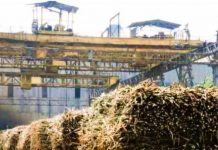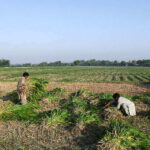Dharmapuri, Tamil Nadu: Sugarcane fields across Dharmapuri district have begun showing signs of distress, with a yellowish-brown tint slowly spreading over the crops in recent weeks. While the discoloration may appear to be caused by poor soil nutrition or dry weather, farmers say the real culprit is a widespread white grub infestation, reports The New Indian Express.
White grubs, the larvae of scarab beetles, have been attacking sugarcane roots, leading to wilting and severe crop damage. Farmers across the region have pointed fingers at sugar mills and the agriculture department, accusing them of failing to detect and address the infestation early.
S. Chinnasamy, a local sugarcane grower, said, “Both the Dharmapuri Cooperative Sugarmill (DCS) and Subramaniya Siva Cooperative Sugarmill (SSCS) had set a combined cultivation target of 12,000 acres. Now, the white grubs are destroying our crops from below the soil. We’ve each spent around ₹20,000 per acre. If this continues, our losses will be huge.”
Farmers also believe that the delay in identifying the pest problem has made the situation worse. G. Murali, another farmer from Morappur, said, “Even fields linked to SSCS have been affected. The infestation could have been spotted earlier. Although these insects have appeared before, this time it’s spreading quickly, and we don’t have the means to stop it.”
Murali added that a key chemical, Chlorpyrifos, used to control the grub, is too costly for most farmers. “The mills have promised to supply it at lower prices, but we fear it’s already too late.”
Responding to the concerns, officials from Dharmapuri Cooperative Sugarmill said, “We’ve advised control measures, but typically these insects thrive in summer. We had good rainfall earlier, and only now the dry weather is encouraging the grubs to multiply.”
P. Priya, Managing Director of SSCS, downplayed the scale of the issue. “There are only small pockets of infestation. It’s not serious enough to assess crop loss. We can manage it with the right insecticides or by flooding the fields. Last year, we asked farmers with past infestations to rotate their crops, and those who followed through are not facing any issues now.”
She added that upcoming rainfall could help stop the spread, and that the situation is not yet a cause for alarm.
Despite these assurances, many farmers remain deeply concerned, fearing that their livelihoods may be at stake if action isn’t taken quickly and effectively.
















